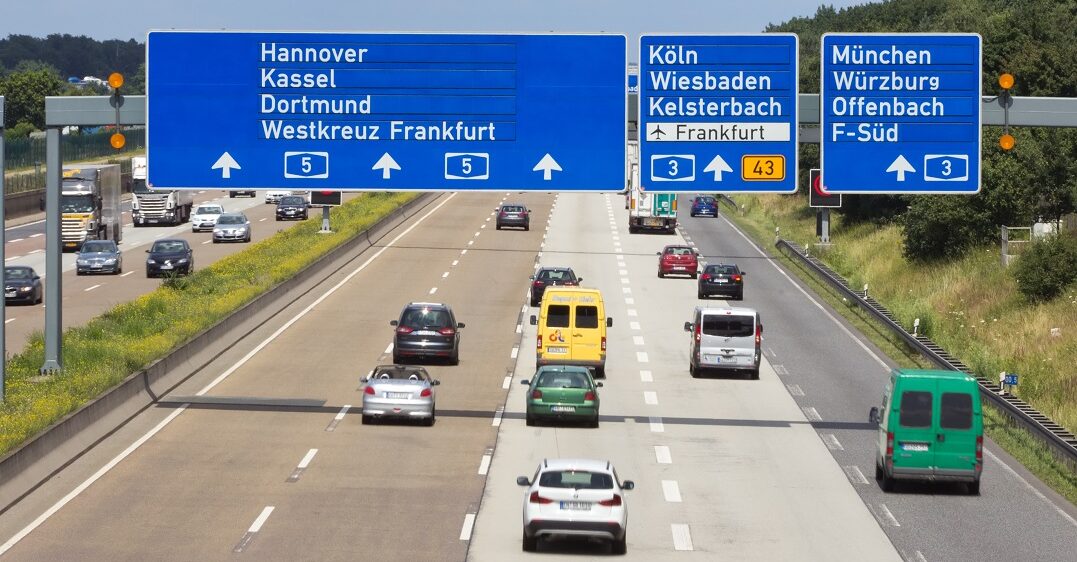by Lea Hauke
Published on July 3, 2023
The rest of the world knows Germany for its beer, its luxury cars and the one place where those cars can really let loose: the German Autobahn. The Autobahn is perhaps best-known for something it lacks — namely, a speed limit. However, this is a common misconception, and only half-true. It’s also not true that anyone can drive on the Autobahn. To take part in this adventure, you’ll need a valid driving license.
Whether you’re looking forward to driving on the world’s fastest roads or you’re worried about surviving in German traffic, you’ve come to the right place. In this guide, we’ll review everything you need to know about the German Autobahn. Together, we’ll take a closer look at the history and common misconceptions of the German Autobahn and tell you everything you need to know about its traffic rules.
The first German highway was constructed from 1913 to 1921 in South Berlin. Upon opening, the 19-kilometer road was considered the world’s first cars-only highway. Another followed it in 1929, when a long stretch of highway between Düsseldorf and Opladen was completed. This was only a few years before Adolf Hitler kicked off his infamous Reichsautobahnen campaign to connect Germany from South to North and from East to West.
Following World War II, approximately 2,100 kilometers of the project had been built — a lot less than Hitler had anticipated. To make matters more complicated, the war had left long stretches of the Autobahn in pretty rough shape . While the repairs moved relatively quickly in West Germany, some parts of the Autobahn could only be re-established after German reunification in 1990. Today, the complete length of the German Autobahn network measures in at 13,192 kilometers.
Let’s address the common misconception that there is no speed limit on the Autobahn. is true that there are sections without speed limits, but this doesn’t apply to the entire Autobahn. Even though roughly 70% of the Autobahn has no speed limit, you should always drive attentively and obey signs that indicate changes in speed.
One thing to keep in mind: It is not mandatory to speed if you don’t feel comfortable. You can always stay in the right lane and let faster drivers pass you, especially if you’re still getting used to driving on the Autobahn. The recommended speed under good conditions is 130 km/h, according to the ADAC (Allgemeiner Deutscher-AutomobilClub).
Driving fast can be fun, but it can also be dangerous if you don’t obey the rules. To prevent accidents and stay safe, keep the following rules in mind.
If it’s your first time on the Autobahn, stay in the right lane as you’re getting acclimated. Especially in sections without speed limits, it can be intimidating to join the faster drivers in the left lane. A general rule: Don’t dwell longer in the left lane than you have to. If there’s a free spot on the right, you should take it to make it easier for other drivers to overtake you.
Drivers on the Autobahn are not allowed to pass cars on the right, even if there’s space to do so. To overtake another vehicle, always change to the left lane.
It can be very dangerous if you forget to set your blinker or check your side mirrors when changing lanes. Especially if you’re trying to change lanes to the left, drivers may approach your car’s rear at much higher speeds than you realize. If they can’t make out your intention to change lanes, accidents can happen pretty quickly.
It’s mandatory to carry emergency equipment on German roads. These include a reflective vest and a warning triangle. In case your car breaks down, park it at the right side of the road and place the triangle 200 meters before your car to warn approaching drivers.
Not every section on the Autobahn is without speed limits. Keep your eye out for signs indicating a change in speed. There are now speed detectors in several places on the Autobahn. Speeding can get very expensive and even cause you to lose your license.
Traffic jams frequently happen on the German Autobahn. It’s essential to leave space in the middle of the road for ambulances or fire trucks in case of an emergency. If you find yourself in a traffic jam, drive your car to the left or the right side of the road. Obeying this rule can save lives.
Driving your car or motorcycle on the German Autobahn for the first time can be exciting, and maybe a little scary. However, if you’re obeying the rules and doing your best to stay safe, it can also be a great experience. As a non-EU citizen, you might have to get your driver’s license converted first, but after that, you’re good to go! If you’re only starting out and plan on taking driving lessons in Germany, refreshing your German will help you a lot in passing your driving test.
Keep in mind that speed limits on the German Autobahn exist, even if the common myth states otherwise. Further, being able to distinguish the different driving signs will help you to stay calm.
